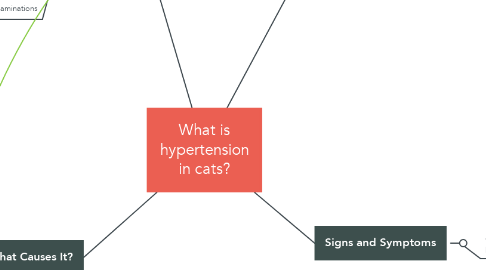
1. Diagnosis
1.1. usually have to diagnose underlying cause
1.1.1. If the disease is know/present for a while
1.1.1.1. regular check ups to monitor
1.1.2. blood work
1.1.3. urine sample
1.1.3.1. urinalysis
1.1.4. assess thyroid hormone level
1.2. Regular examinations
1.2.1. blood pressure readings
1.2.1.1. healthy
1.2.1.1.1. 120-180mmHg
1.2.1.2. hypertensive
1.2.1.2.1. 180-190mmHg
1.2.1.2.2. older cats tend to have higher then younger
1.2.1.3. use minimal restraint techniques
1.2.1.3.1. reduce stress as much as possible
1.2.1.3.2. higher stress
2. What Causes It?
2.1. Secondary
2.1.1. 80% of cases
2.1.1.1. kidney disease
2.1.1.1.1. most common cause
2.1.1.2. obeisity
2.1.1.3. acute or chronic kidney failure
2.1.1.4. hyperthyroidism
2.1.1.5. disease
2.2. Primary
2.2.1. usually unkown
2.2.1.1. secondary causes are more common
3. Treatment
3.1. with
3.1.1. identify underlying cause
3.1.1.1. is obesity the cause?
3.1.1.1.1. diet change
3.1.1.1.2. exercise
3.1.1.2. some drugs that maybe used
3.1.1.2.1. ACE inhibitore
3.1.1.2.2. calcium channel blockers
3.1.1.2.3. diuretics
3.2. without
3.2.1. can lead to death
3.2.2. can cause serious illness
3.2.2.1. can lead to death
4. Signs and Symptoms
4.1. can effect many parts of body
4.1.1. kidneys
4.1.1.1. cause damage
4.1.1.1.1. increase risk of kidney failure
4.1.1.2. if disease is already present
4.1.1.2.1. disease will worsen
4.1.2. heart
4.1.2.1. has to pump harder
4.1.2.1.1. thickening of left ventricle
4.1.2.2. lethargy
4.1.3. eyes
4.1.3.1. complete vision loss
4.1.3.1.1. often permanent
4.1.3.2. blurred vision
4.1.3.2.1. from blood/swelling
4.1.3.3. hemorrhage
4.1.3.4. swelling
4.1.3.5. bleeding
4.1.3.5.1. can be seen when bleeding infront of chambers
4.1.4. brain and nervous system
4.1.4.1. can cause bleeding in these areas
4.1.4.1.1. neurological signs
